Most of us don’t abuse our blades enough to justify the cost of a $400 pocket knife.
Hayley Helms
Every product is carefully selected by our editors. If you buy from a link, we may earn a commission. Learn more
If you’re the typical EDC enthusiast, you probably use your pocket knife for the following: Opening cardboard boxes and packages. Cutting stray strings off your coat, shirt and socks. Prying open a beer. And, once a year, slicing through zip ties on your kids’ Christmas packages.
If you’re anything like me, you use your pocket knife for everyday tasks, not dressing a deer in the field or bushwhacking our way through the backcountry. And that’s perfectly fine!
But if you’re shopping for a new pocket knife and being enticed by the shiny super steels on the market, I have something to tell you: you don’t need it. Skip the add-on, save some money, and just take care of the knife you have.
What is super steel, anyway?
Super steel is a relatively new concept in the world of pocket knives; it’s also a marketing term designed to sell you a more expensive, “premium” pocket knife. Replace “super” with “expensive,” and the result is the same: yes, super steels have certain attributes that make them superior in particular instances over “budget” steel knives, but they also require more energy and resources to produce, and therefore are pricier for you to purchase.
Examples of super steel include MagnaCut (featured on the newest Leatherman multi-tool), S90V (available on Benchmade’s customization tool) and D2, which can be found everywhere from Kershaw to WESN — with the knives themselves costing as much as $400.
I do think super steels are super cool. They represent the literal cutting edge of what’s possible with a pocket knife or multi-tool, which is part of why the Leatherman ARC made our latest GP100. So did a $500 racing shoe. But that doesn’t mean you need it.
Besides, what is considered “super steel” comes and goes as more progress is made: S30V was a super steel 15–20 years ago, and if you’re looking for a knife that can hold an edge with the best of them, it’s a great material to consider (and is now widely available).
Gerber’s Assert uses S30V steel, and its higher price ($175, compared to other Gerber knives that cost half as much or less) reflects that element. Photo by Hayley Helms
What makes a good steel?
There are three important attributes to consider when shopping pocket knife steel: edge retention, corrosion resistance and toughness. Super steels have excellent edge retention, but their corrosion resistance and toughness are on par with cheaper steels. Edge retention’s importance tends to get overinflated; it’s significant, to be sure, but there’s more to a pocket knife than holding an edge (and there are relatively easy fixes out there for a dull blade). Toughness, the steel’s ability to resist chipping or breaking, is equally crucial, but the two traits have an inverse relationship: the tougher a steel is, the harder it is to hold an edge, and the better edge retention, the more brittle the blade.
Super steels are made with powdered metallurgy; budget steels are made with ingot. Beyond those two qualifiers, the rest of the steels available are a balance of the three attributes we just went over; some are more balanced than others, but most will get the (average) job done.
If you want to go deep, here’s an in-depth look at knife steels, tested by a metallurgist — but the long and the short of it is that while super steels can be higher-quality than standard steels, they’re not necessarily better, especially if all you’re doing is breaking down Amazon boxes for the recycling bin. Outfitting your knife with a super steel may feel like an upgrade, but it might just be overkill.
What’s a decent steel, at a decent price?
If I’ve talked you out of that super steel you were eyeing, and you need some other options to investigate, there are plenty of standard carbon steels that will get the job done, and do it well. S35VN, VG-10, 440C, 14C28N and AUS-8 all fall into this category.
When it comes to reliable knives that can tackle most tasks, but won’t break the bank, here are a few of my personal favorites.
Courtesy
The James Brand The Folsom
Crafted with VG-10 blade steel, the Folsom will hold its edge long after you need it to. A steel liner lock, grippy handle and a reversible clip complete the package.
Buck Knives
Buck Knives 661 Small Folding Pursuit Knife
The drop point S35VN steel blade on Buck’s mid-range hunting knife is capable of a variety of jobs, and the non-slip profile, strong lockback and glass-filled nylon handle with Versaflex is a strong enough combo to take into the field.
Kershaw
Kershaw Leek
$114.99
(20% off)
The Leek is popular thanks to its slim design and range of capabilities, courtesy of a three-inch 14C28N stainless steel blade. The anodized aluminum handle is scratch and fade resistant and complements the stonewashed finish of the blade.
